Menstrual cycle effects—Clue study summary and commentary
post by just_browsing · 2021-03-31T16:28:21.748Z · LW · GW · 3 commentsContents
Main findings First finding: The menstrual cycle amplitude is often larger than the daily, weekly, and seasonal cycle amplitudes Second finding: PMS (Premenstrual syndrome) is real PMS sadness increases until age 35, then decreases My thoughts The anecdotal data from my original question roughly matches the Clue data Is there more to it than a heartbeat-shaped curve? Intensity matching: why more precise effects are probably hard to show Specific example: sleep tracking Natural vs societal effects References and footnotes None 3 comments
Two months ago, I posted a question asking how LessWrong users optimize their productivity with respect to their menstrual cycle [LW · GW]. User AM [LW · GW] helpfully pointed me to a 2021 Nature Human Behavior study Daily, weekly, seasonal, and menstrual cycles in women's mood, behavior and vital signs [1] which provides robust, data-driven answers to some of my questions. The study does so by analyzing 241 million self-reported data points from 3.3 million women who use Clue, a period tracking app.
Main findings
I'm summarizing my interpretation of the paper, which means I will cover the facts I find relevant, skip findings I didn't find interesting, and possibly throw in my own interpretations. Please point out corrections if you have any.
First finding: The menstrual cycle amplitude is often larger than the daily, weekly, and seasonal cycle amplitudes
People experience various cycles. For example, the daily cycle consists of waking up, doing stuff, then going to bed. The weekly cycle often consists of a work week followed by a weekend. The seasonal cycle is a year long and (for example) includes the effects of dark winters in the Northern hemisphere.
Women [2] additionally experience a menstrual cycle—a 21-40 day cycle characterized by a period.
It's common to experience fluctuation in mood across each of these cycles (daily, weekly, seasonal, menstrual). Fluctuation in mood can mean lots of things—two examples are the dimension of happy-sad and the dimension of focused-distracted. Insofar as mood changes are caused by a cycle, one might expect to see roughly periodic data with respect to that cycle. And here it is:
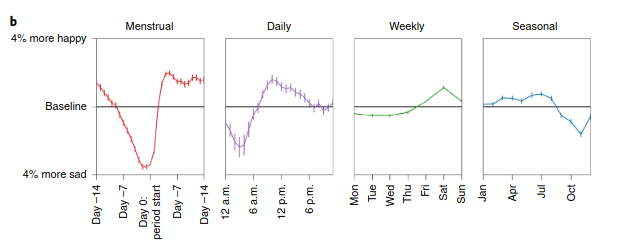
We can see that the menstrual cycle's amplitude is larger than that of the daily, weekly, or seasonal cycle for the happy-sad dimension. This effect was shown to be statistically significant for 6 out of 9 mood dimensions:
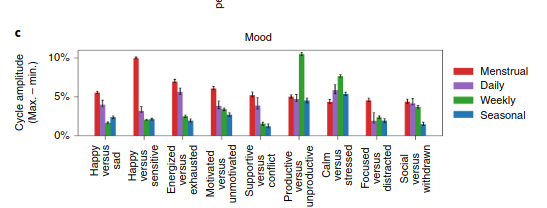
The 2 out of 9 mood dimensions which are dominated by the weekly cycle rather than the menstrual cycle are calm-stressed and productive-unproductive. Here is their cycle data:
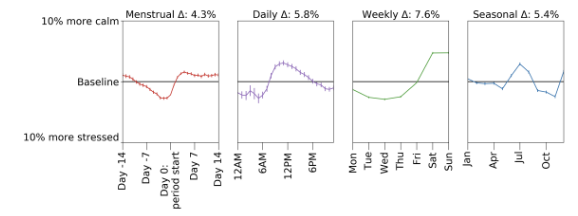
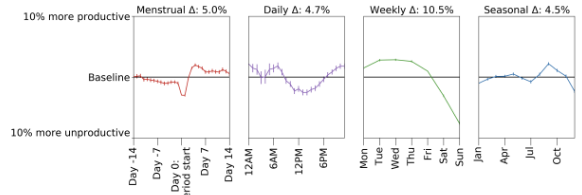
The relative effect from the menstrual cycle is still there—it's just dwarfed by the weekly cycle (specifically, weekends being a thing).
Here is the menstrual cycle's effect on the other 6 mood dimensions (where the menstrual cycle's amplitude was dominant):
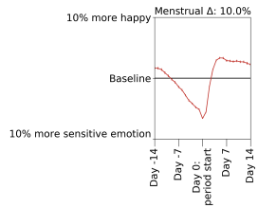 | 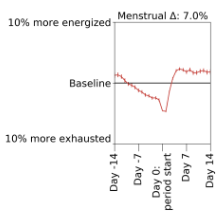 | 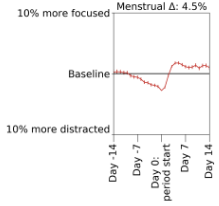 |
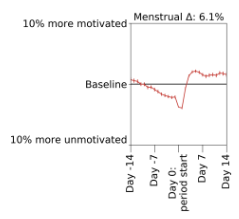 | 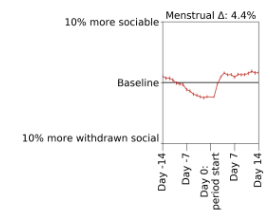 | 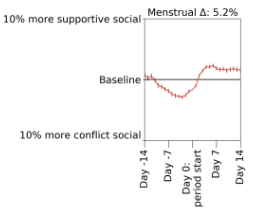 |
| From [1]'s Supplementary Figure 1. |
The same general heartbeat-shaped curve seems to show up everywhere. My thoughts on this are below.
Second finding: PMS (Premenstrual syndrome) is real
The study finds evidence against the idea that PMS is culturally specific by demonstrating that the effect exists in many countries.
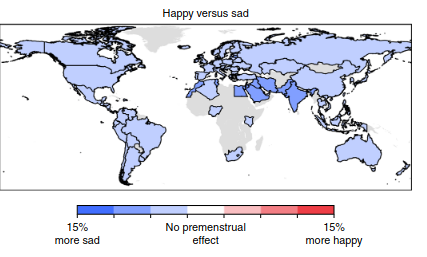
PMS sadness increases until age 35, then decreases
Their data also suggests that PMS effects on mood increase until age 35, then decrease.
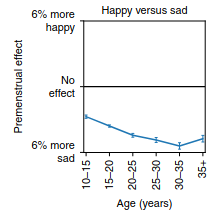
Here is another chart which shows how the amplitude of PMS effects on happy vs sad increase with age.
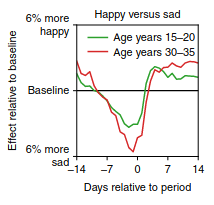
My thoughts
The anecdotal data from my original question roughly matches the Clue data
In my original question "How do you optimize productivity with respect to your menstrual cycle? [LW · GW]", the two people who self-reported perceived energy levels had data which roughly agrees with the Clue study:
Person 1: Off the pill, I find my productivity above-average for about 1 week after my period (I have a very regular 28 day cycle), and frustratingly low for the other 3 weeks (especially the week I am actually on my period). While on the pill, I never get the high of that one post-period week, but I also don't suffer the low before and during my period. [LW(p) · GW(p)]
Person 2: First one-two days of period: [...] I think extremely slowly during this time [...]. Last two-three days of period: Quite neutral state of being [...]. First two weeks after period: More able to concentrate [...]. Third and fourth week after period: [These effects slowly get more and peak in the second week] [...] Emotionally more fluctuating [...] [LW(p) · GW(p)]
Is there more to it than a heartbeat-shaped curve?
My uninformed guess: on a population level, no. On an individual level, yes.
Intensity matching: why more precise effects are probably hard to show
I think the heartbeat-shaped curve shows up across many mood dimensions because a lot of these factors correlate to begin with. I suspect logged data correlates more than the "real data" because everything is self-reported, and people are prone to intensity matching.
Evidence in favor of my hunch: the Clue data also covers RHR (resting heart rate), BBT (basal body temperature), and weight—these are all influenced by the menstrual cycle but in slightly different ways:
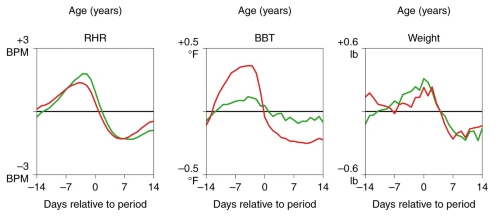
I'd be interested to learn about established techniques besides ("track easy to measure variables") to overcome this intensity matching problem.
Specific example: sleep tracking
I have a sneaking suspicion that the amount of sleep I naturally need varies with my menstrual cycle. Specifically, I think I need around 8.5-9 hours around right before my period is happening and around 7.5-8 hours around when I am ovulating. I haven't been able to corroborate this hunch because I don't track my sleep.
However, the big caveat here is that this only applies to sleep I naturally need. As soon as I wake up to an alarm or go to sleep unusually late, my entire circadian rhythm is (slightly) thrown off. So, my guess is my menstrual cycle will only have these measurable effects if I have a perfectly regular bedtime and never wake up to alarms.
The Clue study looks a bit into sleep, but their findings aren't relevant to what I'm talking about. The app only collects four categories—0-3, 3-6, 6-9, or 9+ hours—and relies on self-reported duration.
There is prior research on how sleep is related to the menstrual cycle. Some findings:
- "significant inverse association between sleep duration and menstrual cycle irregularity"
- "no substantial relationship has been indicated between hours of sleep and most menstrual symptoms" (perhaps because they rely on self-reported data)
- "Young women are more likely to experience sleep disruption in the days leading up to their menstrual period" (good sleep tracking but small sample size)
It seems like my experience of "needing more sleep" is related to increased sleep disruption.
It'd be really cool to measure these effects, but getting a scientific study to do sounds difficult—you'd have to do a massively scaled-up version of the third study listed above, or something similarly expensive.
Natural vs societal effects
I think effects of each cycle (daily, weekly, seasonal, menstrual) on a person's mood (here happy vs sad) can be split up into "natural" (caused by natural processes like human biology and sunlight) and "societal" (caused be societal processes like the work week) effects.
- The weekly cycle is entirely societal because weeks are a social construct.
- The menstrual cycle is entirely natural since the menstrual cycle is a natural process.
- The daily cycle data shows some of both. I can imagine natural effects arising from sunlight and tiredness (not solid on the details, but my understanding of the circadian rhythm is that we wake up alert and build up 'sleepiness' all day) and societal effects arising from getting mentally or physically tired from the work day.
- The seasonal cycle data also shows some of both. I can imagine natural effects arising from sunlight and climate and societal effects arising from holidays, vacations, and other impactful events.
I think this is an interesting framework because natural and societal processes both influence mood, but influencing them requires two different approaches.
Natural problems are solved by learning the relevant biology/psychology behind your problem and exploiting its mechanics. Example natural problem: you feel tired and unproductive because your workspace is not well-lit. Solution: adding a bunch of lighting to your workspace [LW · GW].
Societal problems can only be solved by making society-level changes to your situation. Example societal problem: you feel tired and unproductive because you work best in long uninterrupted blocks, which are rare to come by. Solution: getting a different schedule.
It's a common problem to look at a happy-sad cycle causing someone to function suboptimally and misdiagnose the cause as a societal problem rather than a natural problem. One common example here is people with depression thinking they "need to just snap out of it" rather than treating it with medication.
I think the LessWrong community is much better than average at avoiding this pitfall, since it's keen to explore nonstandard ideas (like assembling a luminator). Just as people experiment with their sleep cycle (using tools like lighting, melatonin, and schedules) to improve their nighttime sleep quality and daytime alertness, I think women should experiment with their menstrual cycle (using tools like different kinds of birth control, varying sleep schedule, and more) to counteract negative effects and boost positive effects. At least, that's my plan going forward.
References and footnotes
[1] Pierson, E., Althoff, T., Thomas, D. et al. Daily, weekly, seasonal and menstrual cycles in women’s mood, behaviour and vital signs. Nat Hum Behav (2021). https://doi.org/10.1038/s41562-020-01046-9
[2] Quoting the paper: "Throughout this paper, we use the term ‘women’ to refer to women and people who menstruate, and ‘women’s health’ analogously; however, not all menstruators are women, and not all women menstruate." Same goes for this post.
[3] Quoting the paper: "To avoid falsely attenuating seasonal cycles, we filter for women in the Northern Hemisphere who log in at least 12 unique months; see Methods."
[4] Removed categories are "Behaviour" and "Vital signs". Here is that part of the chart:
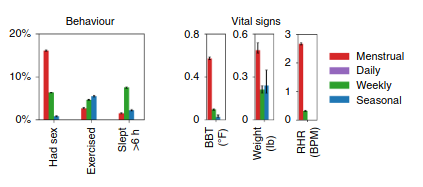
I removed them because I find this data obvious, not actionable, and/or only applicable to the "average person".
3 comments
Comments sorted by top scores.
comment by remizidae · 2021-04-02T12:56:53.712Z · LW(p) · GW(p)
It might be a good idea to point out that there is substantial individual variation in how individual women experience their menstrual cycle. Knowing the averages does not enable you to draw conclusions about what any individual is experiencing. If you find yourself saying, "You must be [X] because of your menstrual cycle," stop. Do not lecture women about their menstrual cycle, do not assume you know more than they do about how their bodies work.
I gather there wasn't any data about cyclic changes in sex drive, but that would be an interesting one to study too.
↑ comment by just_browsing · 2021-04-04T16:04:04.259Z · LW(p) · GW(p)
Yes, I completely agree with this point. I hope I made it clear that I like thinking about data like this exclusively for personal "outside view"-y reflection. So things like, "Oh I haven't gotten anything done this morning, maybe it's because of (x cycle variable), so maybe I can do (y intervention) to fix things". And then, generalizing to other women only in the sense that they might find it helpful to think similar thoughts.
They didn't mention sex drive, but the binary variable "had sex" did come up in the study. However individual fluctuations cancelled out any patterns beyond "more sex on weekends" and "less sex during periods".
comment by AM · 2021-04-05T14:07:51.136Z · LW(p) · GW(p)
Great write-up! I work at another femtech company and will share this with some of my colleagues.
Three thoughts/comments:
1. Clue is very focused on period dates (being a period tracker) and doesn't have very accurate ovulation data. Therefore, cyclical changes in metrics that are affected by ovulation rather than by period will look dimmer due to differences between the length of peoples' Luteal phase. E.g. the BBT signal would probably be much sharper if the x axis was "days relative to ovulation" rather than "days relative to period", since the temperature change is being caused by hormonal changes at ovulation rather than at the period.
2. On sleep tracking, many of my colleagues track their sleep with the Oura ring and have noticed that their sleep is reported in the Oura app as being significantly worse during their Luteal phase (the phase between Ovulation and Period). Turns out this was not due to actual worse sleep, but due to Oura measuring their temperature and picking up on the BBT rise after ovulation. Oura assumed that higher temperatures = worse sleep (in general probably true, but only useful for people without menstrual cycles). Just something to watch out for — surprisingly many products still aren't designed to work properly for 50% of their potential users.
3. Echoing what remizidae says: although these patterns show up with enough data, only a few of them are usable on individuals. I've looked at trying to apply predictive models for several of these metrics on individuals and it's very rare that you get anything that feels more accurate than pure noise. The only exceptions are the really physical ones such as heart rate and temperature.